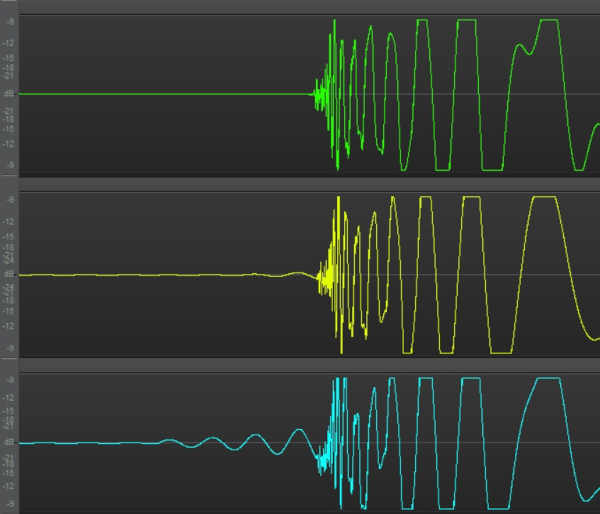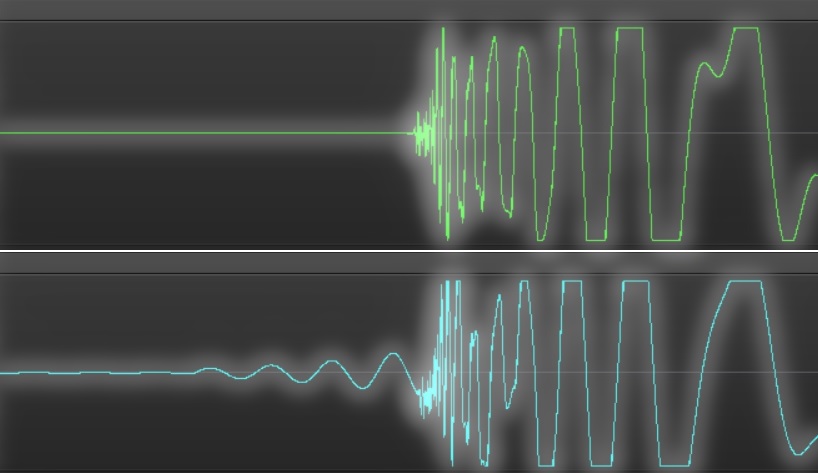No, neither one is evil. Minimal-phase and linear-phase are different equalizer designs. Sometimes minimal phase is called non-linear phase. However, some people may interpret “non-linear” as implying significant distortion. That’s not the case. Minimal phase is arguably more descriptive.
Each design has advantages and disadvantages. Some equalizers offer linear and minimal-phase modes, so you can choose which mode is best for a given application. The user interfaces for both options are similar.
There’s much mythology around this topic. The key takeaways for linear-phase operation are:
- Potentially colors the sound less than other forms of EQ
- Requires more processing power, which may increase latency
- Ideal for parallel processing
- Better than minimal-phase EQ when applying deep, narrow cuts
- May create an undesirable sonic artifact called pre-ringing
- Considered more desirable by some mastering engineers, and less desirable by others
The key takeaways for minimal-phase operation are:
- Has the characteristic sound associated with analog EQ
- Emulations of vintage EQ are all done with minimal-phase designs
- Can add a “character” to the sound, which some engineers prefer
- Usually draws substantially less processing power than linear-phase EQs
- Considered more desirable by some mastering engineers, and less desirable by others
The last takeaway for each category is to remind you that everything has tradeoffs…and everyone has opinions!
Some linear-phase EQs offer a range of precision modes (fig. 1). More precision increases sound quality and accuracy. The tradeoff is increased CPU load and latency (delay through the plugin). It’s common to use lower precision when starting a mix. After finalizing the settings, engineers render the track using the high-precision mode. Rendering retains the audio quality, and allows removing the EQ plugin to save CPU power.
Latency Issues with Linear-Phase EQ

Figure 1: Clicking on the Pro-Q 3’s Linear Phase button brings up a dialog box where you can choose among Zero Latency, Natural Phase, or five precision options for Linear-Phase mode.
Tip: There are a variety of reasons for latency, like a misadjusted audio interface parameter. However, don’t overlook the latency that plugins can add. With some plugins, latency can be significant.
Linear-Phase and Minimal-Phase Differences
Analog equalizers inherently use minimal-phase designs. These introduce phase shifts when you boost or cut a band. You can’t hear this alteration by itself, but combining bands with different amounts of phase shift colors the sound. Some people call this smearing, which may be subtle or obvious, depending on the settings. However, these phase shifts give particular EQs “character.” Sometimes the coloration is desirable, particularly when emulating vintage analog EQ. Any phase shifts are most pronounced with narrow bandwidth and high-Q (resonance) settings.
Linear-phase EQ delays the audio at different frequencies by different amounts. This ensures that all bands are in phase, which allows for accurate, predictable equalization. Some people refer to linear-phase EQ as surgical EQ because of its precision.
When applying a massive treble boost using minimal-phase or linear-phase modes, the audio processed by a linear-phase EQ usually sounds more transparent and “airy.” Audio processed with minimal-phase EQ has a particular character you might prefer for some individual tracks or mixes.
Linear-Phase Limitations
Linear-phase equalizers aren’t perfect:
- As mentioned previously, they add latency because they delay the signal by the longest time needed to get all the frequencies in phase. So, your host recording software must delay all your other tracks by the same amount of time. If it didn’t, the tracks being processed with linear-phase equalization would sound late compared to the other tracks.
- The responsiveness of controls may seem sluggish because of all the background computations that are needed. Automating linear-phase EQs may or may not be practical.
- Linear-phase equalizers can also add pre-ringing, a low-level, “swooshing” artifact before transients. Let’s look at this in more detail.
Linear-Phase EQ and Ringing
Normally pre-ringing isn’t an issue. It’s most audible at relatively low frequencies with high gain and Q (width) settings, although it can happen at any frequency. However, some other musical genres emphasize bass. When adding high-gain/high-Q settings at low frequencies, a minimal-phase EQ might be a better choice. Reducing a linear-phase EQ’s precision setting also reduces the potential for ringing.
Fig. 2 shows kick drum pre-ringing with high-gain, narrow-width settings. It’s zoomed way in vertically (this is why the kick appears clipped, even though it isn’t). Otherwise, you wouldn’t see the low-level pre-ringing.

Figure 2: Pre-ringing is noticeable at extreme settings.
Here’s what you’re seeing:
- The green (top) waveform has a gain of 10 dB and Q of 10, but uses traditional, minimal-phase equalization. There’s no pre-ringing prior to the attack. Note that the waveform is a flat line up until the attack hits.
- The yellow (middle) kick drum waveform uses linear-phase EQ with a gain of 5 dB, and a Q of 5, at 100 Hz. You can see a little pre-ringing as a slight ripple in the wave just before the attack.
- The blue waveform (bottom) shows the same kick through a linear-phase equalizer, also with a boost at 100 Hz. But this waveform reflects doubling the gain to 10 dB, and narrowing the width to 10. At this relatively extreme low-frequency setting, the wavy line before the attack is obvious. You would hear this swooshing sound.
Let’s hear what pre-ringing sounds like. The following audio example plays two snare drum hits. Both have a 15 dB boost at 180 Hz with a Q of 10. The first uses minimal-phase EQ. The second uses linear-phase EQ. Note the “swoosh” at the beginning of the second snare hit.
Ringing doesn’t happen only with linear-phase EQ. Minimal-phase EQs can exhibit “post-ringing” with transients. Unlike linear-phase EQs, this causes ringing after the transient occurs. Post-ringing tends not to be noticeable, because the audio that follows a transient masks the ringing.
Neither pre-ringing nor post-ringing are deal-breakers, because they tend to matter only at relatively drastic settings. Nonetheless, it’s important to understand these phenomena. Then you can choose the appropriate EQ response. In most applications, pre-ringing will not be audible. If it’s severe enough to be audible, use a minimal-phase equalizer instead.
Does This Really Matter?
When comparing phase-linear and minimal-phase modes, a minimal-phase mode’s phase shifts can add a bit of an upper midrange “edge.” Linear-phase operation sounds more neutral. Also, for a given amount of gain, linear-phase mode will sound like it has less of an effect, because its sound is more transparent.
Regardless, the music is way more important than the EQ mode. Linear-phase equalization has its uses. But if only traditional EQ existed, the earth would continue to rotate on its axis. However, linear-phase and minimal-phase EQ do matter with parallel processing, as described next.
Parallel Processing with Linear-Phase EQ
Linear-phase equalization’s freedom from phase changes is particularly important with parallel processing. The phase changes produced by a minimal phase equalizer, when mixed with a dry signal in parallel, alter the sound in ways beyond those intended by the equalization. Phase-shifter effects, which mix a phase-shifted signal in parallel with a dry signal, exemplify how phase shifts influence the combined sound.
Highpass Filtering with Linear-Phase EQ
Many engineers reduce unneeded low frequencies to solve common problems (e.g., remove vocal p-pops or mic handling noise), or for artistic reasons. Standard EQ introduces phase changes above the cutoff frequency, but with linear-phase EQ, there are no phase issues. This phase integrity guarantees that for doubled audio sources with slightly different EQ settings, there won’t be audible smearing above the cutoff frequency. So, engineers often use linear-phase EQ to reduce low-frequency artifacts in the frequency range below vocals.
…and that ends our adventures with linear-phase EQ, at least for now. I hope you found it useful!
